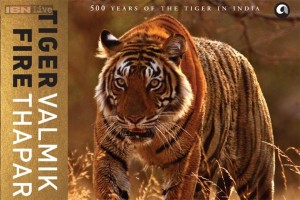Book Review: Tiger Fire
Tiger Fire
Valmik Thapar
Aleph Rs 2995/-
Let me state u pfront that there is an inherent bias to have a tiger aficionado review a book that celebrates this magnificent big cat. That said, the fact of yet another tiger book—at last count over 20––from the world’s best known tiger conservationist did make me wonder, what can the author offer that is new, or pushes the envelope to justify its considerable price?
pfront that there is an inherent bias to have a tiger aficionado review a book that celebrates this magnificent big cat. That said, the fact of yet another tiger book—at last count over 20––from the world’s best known tiger conservationist did make me wonder, what can the author offer that is new, or pushes the envelope to justify its considerable price?
Spectacular as tigers are––or more precisely, because they are, I find them to be a difficult muse. How does one, for instance, encapsulate a tiger––in all its magnificence and mystery, in words or even pictures? One cannot, but I must admit, Tiger Fire delivers. It is an extraordinary assemblage of anecdotes, reports, writings, art and photography on the tiger down the ages—from Mughal Emperors Babur, Jahangir and Akbar—who detail the methods of tiger hunting including one which entails “getting on the back of a male buffalo and making it attack the tiger”. There are, expectedly, accounts of tiger hunts by the sahebs, and equally, there is prose on “Hindoostan’s splendid forests” or pithy commentary on the English penchant for the tiger hunt, “Tygers used to be very common, but since the English have frequented the country, are scare, and in comparison, very shy.” There are remarkable natural history notes—including tussles of tigers with crocodile, python, elephant, wild boar—and the unusual case of the tiger partial to hunting bears. Of particular interest are anecdotal accounts on tiger behaviour like the one which establishes curiosity in tigers, or the experience of one Richard Hilton whose boots the tiger sniffed, and disdained. Incidentally, both lived to tell the tale, and the tiger “mooched off into the jungle” after this extraordinary event! Fascinating, too, is a record that defines the tigers range as well over 14,000 feet above mean sea level—particularly considering the great hullabaloo recently of the ‘discovery’ of tigers over 10,000 feet in Bhutan.
Moving onto more contemporary times, there are accounts by naturalists, conservationists, scientists, and the best known authorities on the tiger. Thapar also draws from his own repertoire of books, including The Secret Life of Tigers.
There is a narrative of a fiercely protective tigress attacking a huge tusker to protect her young—and an almost unbelievable story from Ranthambhore of a male tiger being daddy—bringing up, and shielding his young, followed by another of the ‘babysitter’, a young sub-adult male who tended to his younger siblings when the mother went hunting. It is stories such as these which will especially appeal to those not wedded to the tiger, the lay reader who is bound to be intrigued by these largely unknown, and engaging facets of the tiger. There does seem to be scant inclusion on scientific writing on the tiger, or perhaps this is a reflection of a problem pointed out by the author––the government’s lack of engagement with ‘outside’ experts, including scientists.
Like all of Thapar’s books, this one too, is a labour of love, written with passion and heart, and no mean effort. The author has researched, one imagines, just about everything written on the tiger in India, and presented us—in a very aesthetic manner––choice pickings.
Tiger Fire is akin to a library, with distinctive five sections or ‘books’ which cover the tiger’s origins, writing between the 16th century to the current times, Thapar’s works, spectacular images from India’s top wildlife photographers. The final section, Last Tigers focuses on the animal’s precarious future, bringing in a grim tone on what is essentially a glorious celebration of this big cat. Thapar delves in meticulous detail the local extinction in Sariska and Panna and the government’s consistent denial of the crisis which led to this situation. The one snag here is the glossing over of what one perceives as a key threat to the tiger today—loss and fragmentation of habitat, increasing anthropogenic pressures and the consequent escalating human-wildlife conflict.
Also, while there can be no two opinions on the immense contribution of the seven people singled out as ‘tigerwallahs’, it fails to be inclusive of other unsung heroes fighting for the tiger.
That apart, Tiger Fire is a one stop shop on all things tiger. A definite must-have for those who care for, or interested in the tiger—and a hook to those not yet initiated.
Reading the book was a fascinating, almost humbling experience. Even for one who devours literature on this big cat—Tiger Fire offered something new. It renewed my acquaintance, left me a little more smitten, even more intrigued. And therein lies the beauty of this beast, who retains its mystery and its magic-which are well reflected in Tiger Fire.
By Prerna Singh Bindra
A lightly edited version of this review appeared in The India Today magaine this week